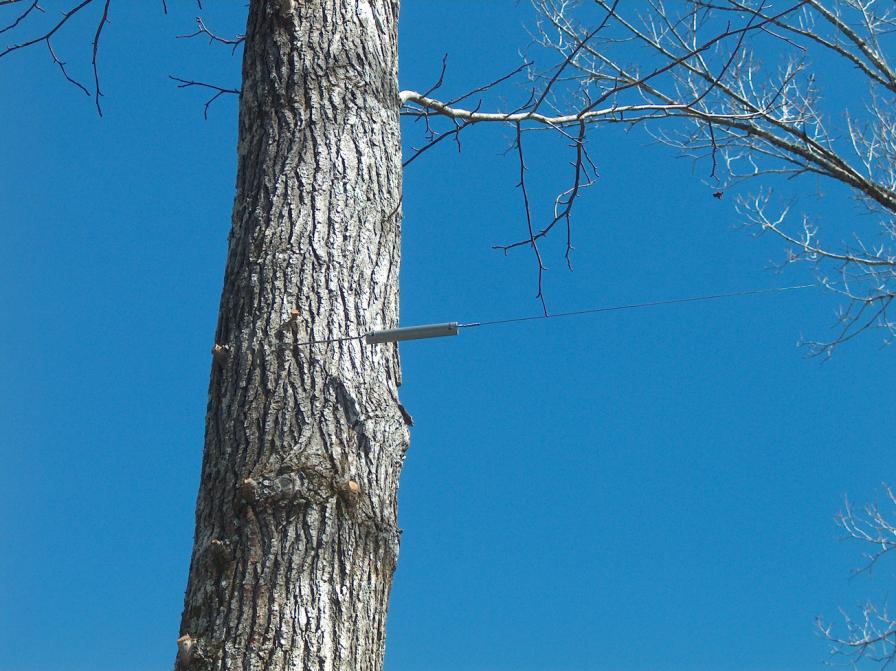
160 Meter Dipole Antenna at W5JGV
At the new QTH in Natchitoches, Louisiana
by W5JGV
Match 19, 2007
It's been a few months since Bonnie (KB5YSE) and I moved to our new home in Natchitoches, Louisiana. We relocated here about a year after hurricane Katrina substantially rearranged our lives. We managed to retire (again) and plan to spend a lot of tine doing all the things we have always wanted to do, but never quire seemed to find the time to do. You know how that is!
One of the things we have planned to do is to erect another building close to the house. the new building will become part art studio for Bonnie, part storage for all the extra "Junque" we have accumulated and can't bear to throw away {1}, and part Ham Shack for our radio gear and my experiments. There's already a shop where I can do my mechanical and woodworking stuff. But, we haven't got around to constructing the new building yet, so the hamshack, such as it is, is presently confined to a very small corner of the laundry room, along with the rack full of computer networking hardware and Internet satellite equipment.
Well, I quickly realized that I needed some sort of an antenna if I was to work anybody on the HF bands. As a first try, I ran some 17 gauge aluminum electric fence wire from the side of the house closest to the "hamshack" out to a handy tree about 20 meters or so away from the house. I used a length of twine to hold the wire to the tree, and a couple of electric fence insulators at the house. Using a spare 1:4 balun connected between the antenna wire and the house water pipes, I connected the balun input to some old cable TV coax and ran it inside the house under the door and on to the antenna tuner. The rig, of course, is one of my two Yaesu FT-747GX's.
Well, it worked - sort of. I could hear stuff on just about every band, and even make contacts! But - I also "contacted" all the TV's in the house (no cable here; the closest major market TV station is about 55 miles away), the house alarm system, and every computer speaker in the house, as well as several of the Ground Fault Circuit Interrupters. Not good. I figured I had better get the antenna away from the house. Now.
After a leisurely walk around the estate with tape measure in hand, I managed to locate several nicely spaced trees that looked as though they would serve to hold up a 160 meter dipole. Did I mention that we have trees here? Lots and lots of trees. In fact, about 12 acres of them. It's hard to site an antenna for the forest full of trees. I had to run the antenna between the trunks of the trees. That (and the fact that I could not figure out hot to get really high in the trees) limited me to installing the antenna at about the height of my extension ladder and below the major tree branches, which turned out to be about 20 feet above the ground.
The antenna is oriented on a North-South axis, more or less. It dog-legs a bit around several trees, but that does not seem to interfere with its operation at all. It is fed with home-made open wire feedline. Let's take a look at some of the pictures...

This is the North end of the antenna. A big screw is placed in the tree, and a 16 cm length of gray PVC pipe was used as an insulator. The antenna wire is some of my handy 17 Gauge aluminum electric fence wire. It's strong enough to hold up pretty well to the wind, and becomes almost invisible after a few weeks in the weather.

The South end of the antenna is attached to its supporting tree in the same manner as the North end. If you look closely, you can see the screw in the tree trunk.

Where the antenna wire passes close by several trees, it is held away from the tree trunk by the use of a nail-on electric fence insulator. The antenna wire is not fastened firmly to the insulator, but is allowed to slide freely through it.

The center of the antenna is where the real action takes place. I screwed a length of thin wall electrical metallic tubing (EMT) to the tree trunk and attached four heavy "screen door" springs to the EMT. The springs running to the left and right in the picture apply tension to the insulators that are attached to the North and South legs of the dipole antenna. The springs running towards the top of the picture apply tension to the insulators that are connected to the open wire feedline running back to the house and hamshack. If you look carefully, you can see two yellow "wire nuts" apparently suspended in the air between the dipole arm and feedline springs. They are where the feedline connects to the dipole arms.

A close-up view of the EMT as it is attached to the tree.
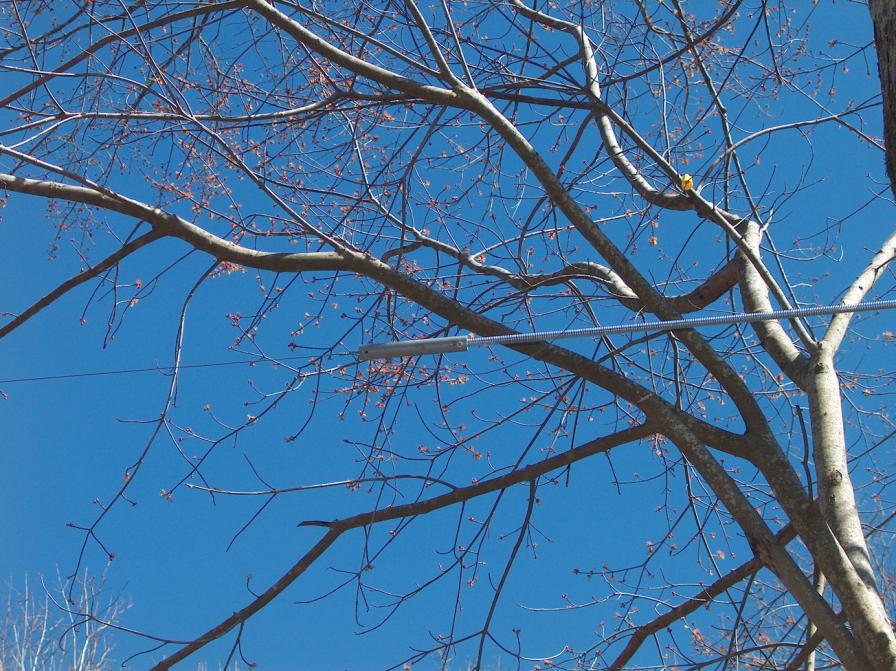
The springs are attached to the PVC pipe insulators using a "dry-wall" screw driven through the pipe. That saves drilling a hole! (Did I tell you I'm lazy?)

This is a side view of the center of the dipole and the feedline, which is visible from left to right in the picture. The feedline is made from the same 17 gauge aluminum electric fence wire as is the antenna. (I have lots of it on hand!) I didn't bother to calculate the impedance of the line, since the loss is so low anyway. The wire-to-wire spacing is about 23 cm in case you're curious and want to calculate the Zo of the line. No insulators were used, since the spring tensions the feedlines very well and they don't move relative to each other when the wind blows.

The feedline is just visible running across the picture. The shack is to the left, and the antenna is to the right. The feedline is about 31 meters long. The mound of earth in the foreground is not a fire ant hill (although some do get almost that large) but is leftover dirt brought in to fill some tree stump holes after trees uprooted by hurricane Rita (Sept 2005) were removed.

At the hamshack, the feedlines terminate at insulators mounted under the eves of the house. They are led into a 60 Ampere DPDT switchbox so that the feedlines can be disconnected from the shack and grounded during storms. There's a ground rod set into the earth directly beneath the switchbox. This is also connected directly to the solid copper cold water pipes in the house.
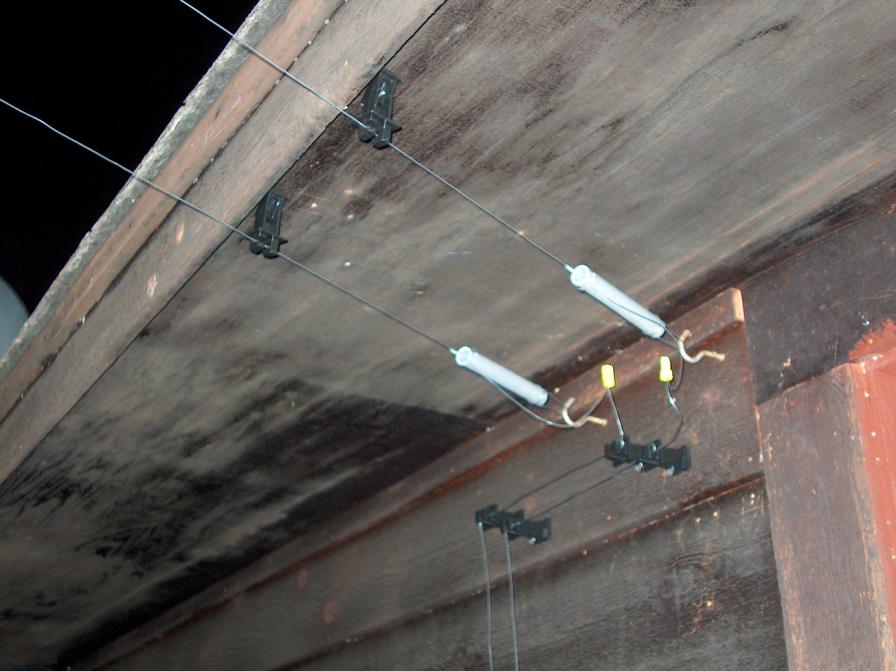
The feedlines are held away from the eves by using two nail-in electric fence insulators. More of these insulators are used to support the feedlines as they go down to the switch box.

A better view of the shack end of the feedlines.

Inside the switch box. Although this switch was designed for 60 Hz use, when the RF power level is limited to 100 watts, there is no noticeable heating of any of the insulators in the switch. You can see the open wire feedlines entering at the bottom left of the box. The white wire exiting the box at the lower center goes to the ground rod. The switch is shown in the feedline grounded position. Entering the box at the lower left is the 300-Ohm twin-lead that connects the switch to the antenna tuner inside the hamshack. It is centered in the silver-colored fitting where it enters the box by using some closed-cell polyurethane foam of the type used to insulate water pipes. Another length of this foam is used to space the twin-lead away from any metal objects inside the box.
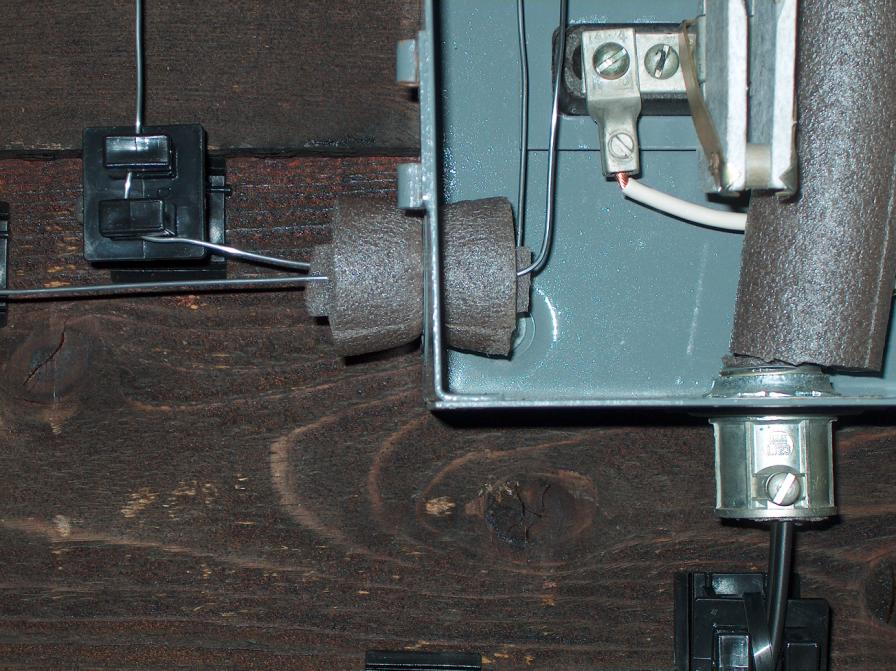
This view shows how the foam is used to insulate the feedlines from the metal case of the box. It also keeps rain water and insects out of the box interior.
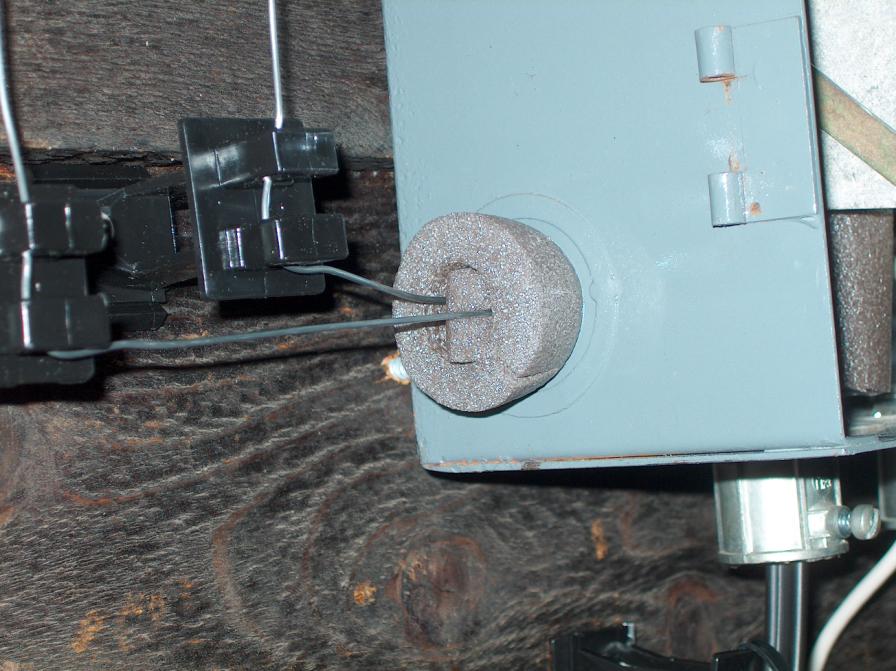
This oblique view shows how I cut a section of the foam and stuffed it in between the feed wires to prevent them from short circuiting.
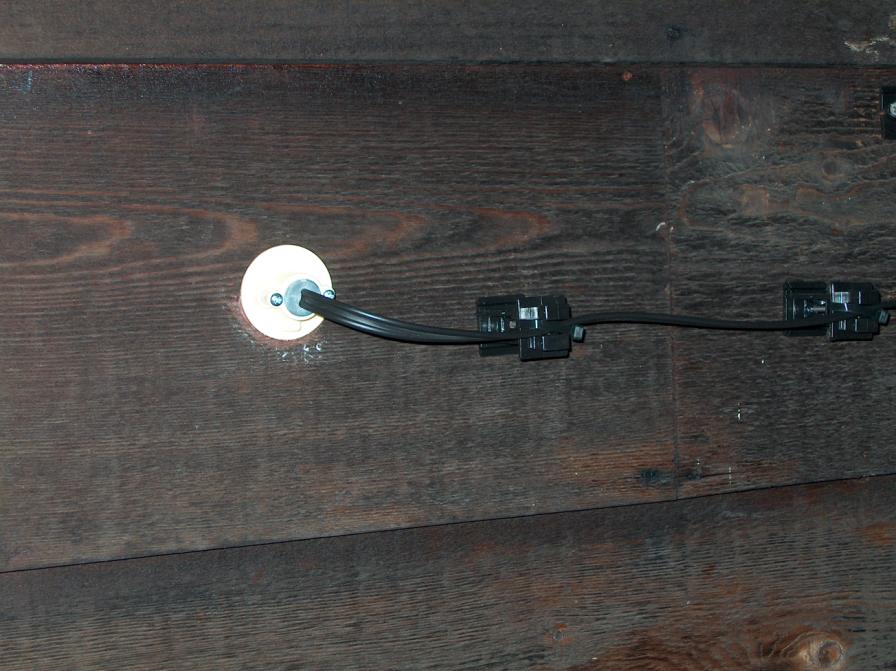
Finally, the 300-Ohm feedline goes through the wall of the house to the antenna tuner. I used one of those polystyrene plastic tube assemblies that were commonly used for just this purpose years ago when outdoor TV antennas were more common. I hadn't seen one in years, but guess what - the local Radio Shack store in this area still sells them! Since they are cheap, I bought a bunch of them. They are useful for getting wires and cables through walls and for cutting into short lengths to make low-loss coils.
I mentioned before that the antenna is almost invisible - see of you can find the antenna in these pictures!

The feedline is running to the left.

The South end of the antenna is to the right center of the picture.

This is the middle of the South leg of the dipole.
The only time the entire antenna is truly visible is when the sun is just over the horizon and the antenna is wet with very fine dew drops. I expect that after the trees grow their leaves, it will be very hard to see the antenna at all. I just hope the leaves don't absorb all the signal
Notes: {1} Stuff - The Junk you Keep. Junk - The Stuff you throw away.
73, Ralph W5JGV
[Home]
The entire contents of this web site are Copyright © 2007 by Ralph M. Hartwell II, all rights reserved.